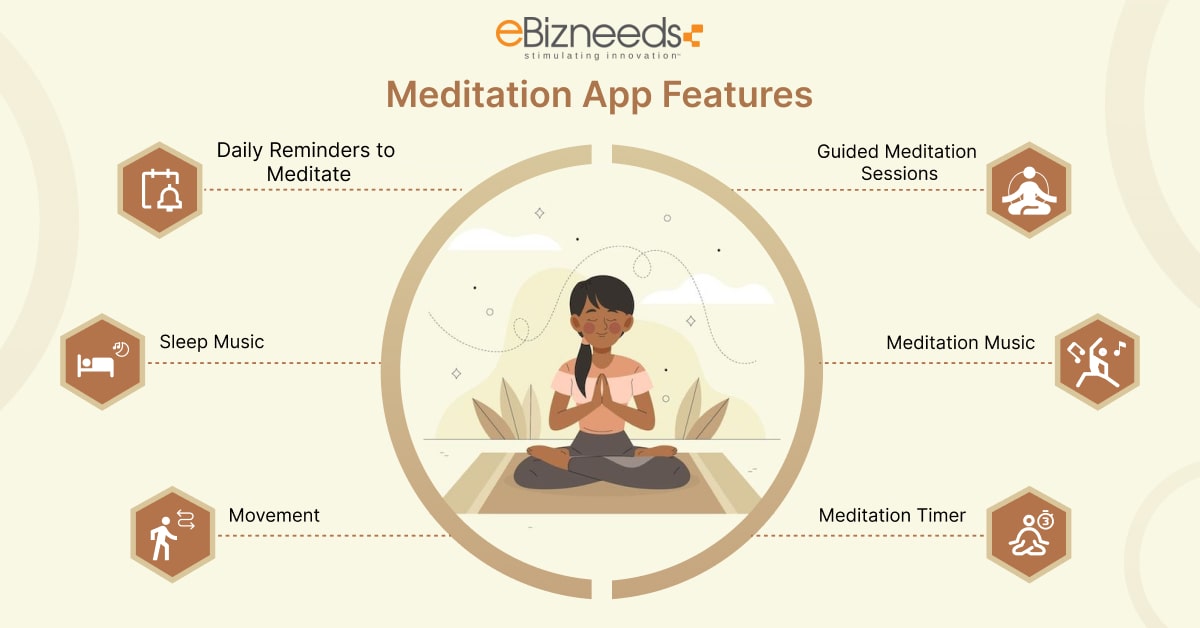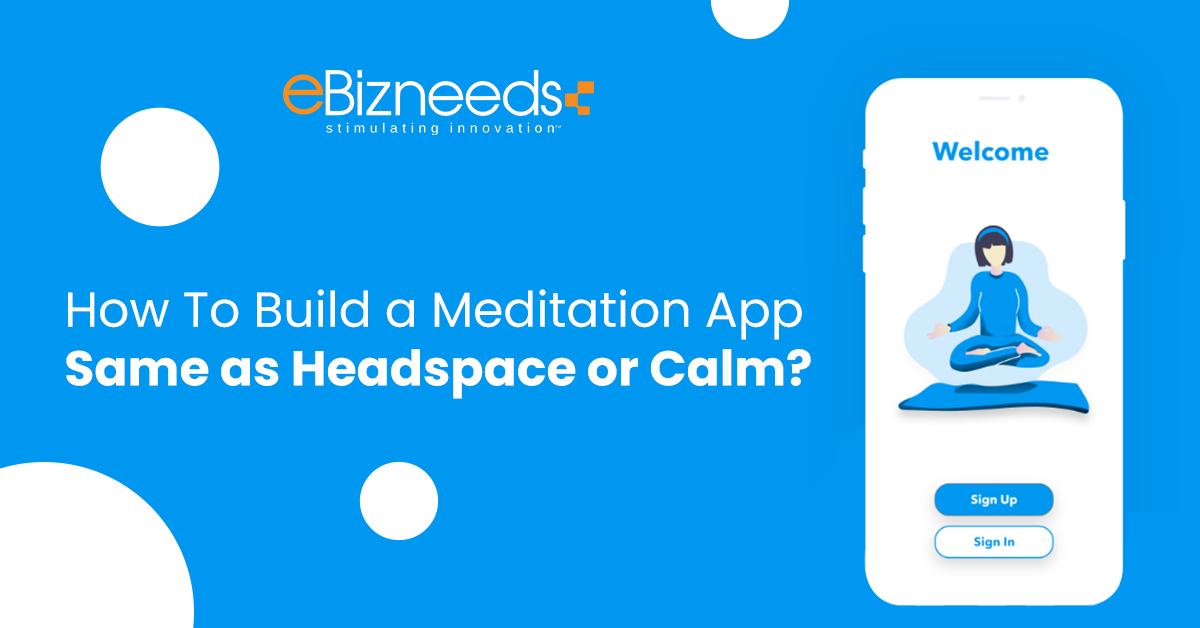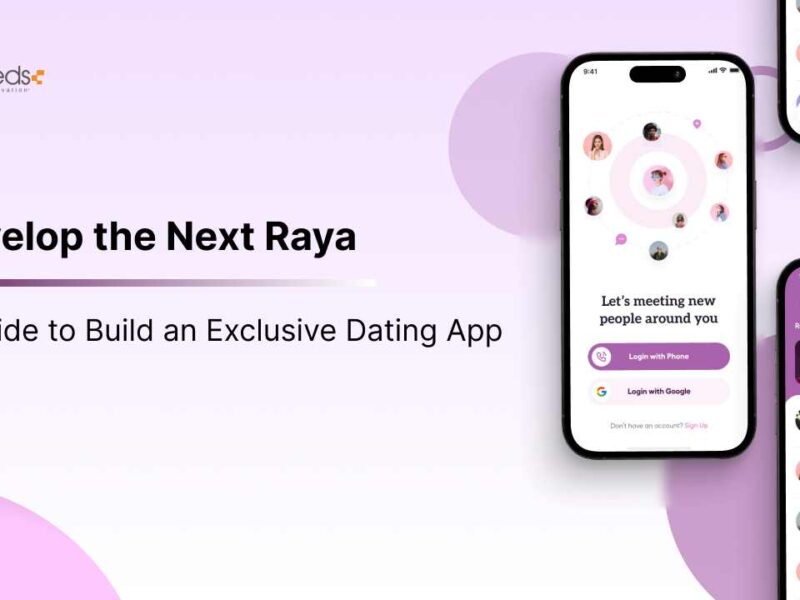Meditation is one of the oldest techniques to keep the mind calm and stay fit in terms of mental health. Earlier, it could have been done under the guidance of meditation experts or some Gurus, but due to the evolution of technology, you can have personal meditation expert with the help of an app like Headspace or Calm.
The meditation app development is progressing and trending as well. Millions of people use to take benefits of these meditation apps to make their life better.
If you want to start your own meditation app, then you have come to the right place. As meditation and mindfulness becomes more popular in today’s society, people are looking for different ways to implement this practice into their daily lives.
From work to school and even at home, everyone should know about how to build a meditation app that offers great results and conveniences like Headspace or Calm. Let’s get started!
Have you ever wondered how to build a meditation app for daily calm? If so, then this article will help you achieve that goal!
Whether you’re building your first meditation app or your 10th, this guide will help you with everything from knowing if it’s the right time to launch such an app (it probably isn’t), to selecting the right meditation experts to include in your app, to marketing your app and getting users excited about it.
Steps To Develop An App Like Headspace or Calm
Building your own meditation app can seem like an impossible feat, but it’s easier than you might think. If you want to build the same meditation app as Headspace or Calm, there are a few things you can do to get started right away.
The first step to building your own popular meditation app, whether it’s for Android or iOS devices, is finding an experienced team to design and develop it. This is because the process of creating an app involves many different components that need to come together seamlessly.
Step 1 Identify Your Goal
Developing a meditation app like Headspace is not an easy task. The app must be engaging, comprehensive, and accessible for beginners.
It should include guided meditations that are developed with the user’s voice in mind. You need to develop soundtracks that are soothing, calming, and relaxing. With your knowledge of mindfulness and cognitive behavioral therapy, you will also need to work on how the app handles difficult emotions like anxiety and anger.
The most crucial point to developing a calm app like Headspace is to develop its idea first. Here you need to choose between that whether you want to develop a unique meditation app or do you want to develop a Headspace clone app.
Step 2 Research the Competition
There are multiple meditation apps available in the market, and they have their own fanbase. If you want to develop a meditation app for business, then you need to do extensive research about market trends, statistics, and competitors.
It will give you an idea of what you need to make your app unique. you face any difficulty while researching, then it would be best to take expert pediatrician feedback, which will refine your app even more.”
Anchor: expert pediatrician feedback having experience in building a meditation app.
Here you need to look into the meditation apps available in the market:
- What are the features available?
- On which platforms are meditation apps available?
- What are the features in an app like Headspace or Clam that draws the attention of users?
- How much does it cost to develop a meditation app?
- What technology can you prefer to develop a meditation app?
And more.
Step 3 Choose Your Platform
The next important step or thing that you need to focus on while developing a meditation app is to choose a platform on which you can launch your app.
Most of the users are scattered between two platforms one is iOS, and Another is Android. The percentage of Android users is more, and that is 71%. But, on the other hand, iPhone has its own fanbase.
Both platforms are the best to launch the meditation app. The third platform is the Web platform, where you can launch the PWA app with the help of a web development company.
Actually, it is your choice on which platform you want to launch your app. Things will go accordingly.
Suppose you want to launch your app on Android, then you need to take the help of an Android app development company, or if you want to launch your app on the iOS platform, then you need to take the help of an iPhone app development services provider.
Step 4 Hire Mobile App Development Company
If you are considering starting the development of your own meditation app, you may want to consider hiring an experienced Meditation App Development Company.
This will reduce the risk that your idea will take too long and be too expensive, as well as ensure that it is designed in such a way that users will find it easy to navigate and use.
When hiring a Meditation App Development company, there are some key questions that need to be answered before getting started:
-What languages do they code in?
-What type of experience do they have?
-Is their software scalable?
-What kind of clients have they previously worked with?
-Can they provide case studies on previous work?
-What is their budget range for this project?
-Can you communicate with them easily?
These questions should all be answered during the initial consultation before diving into any actual coding.
Step 4 Design Your App
Once you hire the app development company now, its time to design the app with the help of experts, a dedicated mobile app Development company has both resources and experience with the apps they are trying to create.
They already know the technologies necessary for the development and what platforms are popular among users, so you won’t need to waste time wondering which ones might work for your needs.
Step 5 Develop Your App Like Headspace
Developing an app can take a lot of time and money, so it’s important that you plan your goals carefully. Make sure that you’re targeting the right audience, have enough funding and resources to build your app, and know what features your app should include in order to be as successful as possible.
Once you’ve done all of this, finding developers for the project is essential. There are many on-demand app development companies in the market today that offer services for developing apps like headspace or calm.
The app development part consists of developing components for the frontend and backend. Once the development part is complete, then next thing to do is a test and launch the app.
Step 6 Test & Launch Your App
Testing the app before launch is most crucial than development. It is necessary to find and eliminate all the glitches in the app before launch.
While developing the app, there are chances that some little things should have been noticed by the developers. Later these missing things can create havoc or bitter the user experience. So, testing ensures the removal of all the bugs before the launch of the app.
How Much does it Cost to Develop a Meditation App Like Headspace or Calm?
The cost of developing a meditation app like Headspace largely depends on the features you want to include in your product like breathing exercises, bedtime stories, and more. The more features you plan to include like family plan, the higher the price will be.
The first step is to find out how much it will cost for a developer to build your app. This is because developers charge different rates for their services, and it’s best if you know ahead of time what your budget is before hiring anyone.
Cost can also depend on whether you are an individual or a company developing the app. For example, if you are an individual, then it’s best if you decide on the features beforehand and hire someone who can do the work in that specific field.
This way, they will be able to give you a good estimate from the start rather than changing their rate as they go along and find out what needs to be done next.
The cost of developing a meditation app like Headspace is dependent on the features that it will have and the budget set for it. There are many factors that affect the cost of building an app. Some of them are:
– The number of features in the app
– The complexity level of these features
– The type, size, and number of screens in the app
– The device compatibility requirements
– The time taken to complete the development
– Whether you need to hire a team or not
If we talk about the actual cost, then it is not easy to predict, but yes, we can analyze the average cost. Suppose if you want to develop a basic meditation app with essential features, then it will cost you around $15000-$30,000 initially, but if you want to build a meditation app with advanced features and functionalities like live video streaming, audio streaming, and more then it may cost you near around or more than $45,000.
The location of developers is also the biggest factor in the cost of building a meditation app. It is like the location you choose to hire the developer; they will cost accordingly.
| Location
|
Cost Per Hour
|
| North America
|
$200-$300 / hr |
| South America
|
$150-$200 / hr |
| Europe
|
$120-$150 / hr |
| Africa
|
$100-$120+ / hr |
| India
|
$20-$40 / hr |
The idea is simple the version you want it will cost accordingly that you can also confirm from on-demand app developers. The average cost will be like-
- Simple Meditation App Development Cost –$20,000 to $30,000
- Average Meditation App Development Cost – $30,000 to $50,000
- Complex Meditation App Development Cost – from $50,000
Features of Meditation App Like Headspace or Calm


Meditation app development is the process of developing an app that offers guided meditation sessions and other mindfulness-related content.
Meditation apps like Headspace and Calm are becoming popular with people who are looking for ways to manage their stress. These apps offer guided meditation sessions that are tailored to the user’s needs. They also provide additional tools, such as meditations for focus, anxiety, or to fall asleep.
There are many meditation apps available on the market today, but not all of them are created equally.
The features that a meditation app like headspace offers vary from one to the next. Some of the most popular apps in this category include Headspace and Calm.
Headspace is a subscription-based app that helps people with their mental health and well-being by providing guided meditation sessions. On the other hand, Calm is a free app that offers more than 2500 meditations to choose from, including ones for sleep and anxiety relief. There are many other which initially provides users feature to access free trial and then make an informed decision.
The most popular features of these apps include the following:
– Guided meditation sessions: Unlike unguided meditation, these sessions will guide you like you are doing meditation under some expert.
– Meditation music: a user can choose a music file doing meditation at their comfort.
– Meditation timer: while meditating, you can set the timer from 10 minutes to 30 minutes or more.
– Daily reminders to meditate: users can set on or of for daily reminders to meditate.
– Sleep Music: Suppose a user feels uncomfortable sleeping due to stress; then they can play sleep stories to help him sleep better.
– Movement: users can also learn yoga poses to stay better with their body and soul.
The Conclusion
Building an app is always challenging. But by following the steps above, you can ensure success in the process of building your own meditation app.
You should start with researching and developing your idea, finding an app development company, defining the features that you want, figuring out which type of users you want your app to target, and finally, making sure that you have enough funding for this project.
With these steps, you will not only be able to build a meditation app but also stay on budget and be successful in doing so!



Naveen Khanna is the CEO of eBizneeds, a company renowned for its bespoke web and mobile app development. By delivering high-end modern solutions all over the globe, Naveen takes pleasure in sharing his rich experiences and views on emerging technological trends. He has worked in many domains, from education, entertainment, banking, manufacturing, healthcare, and real estate, sharing rich experience in delivering innovative solutions.





